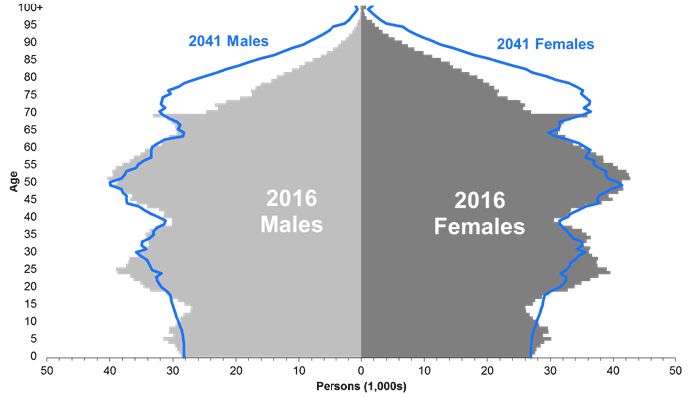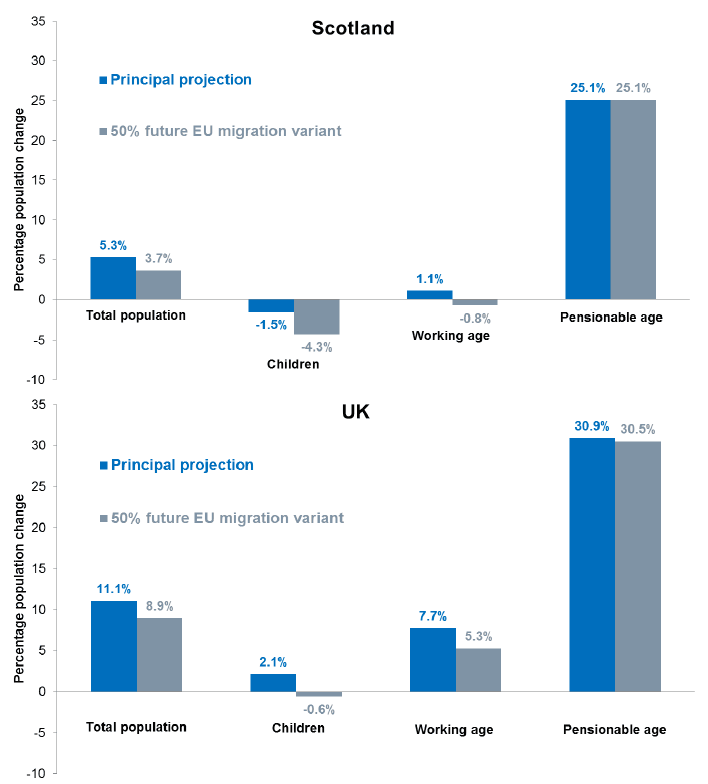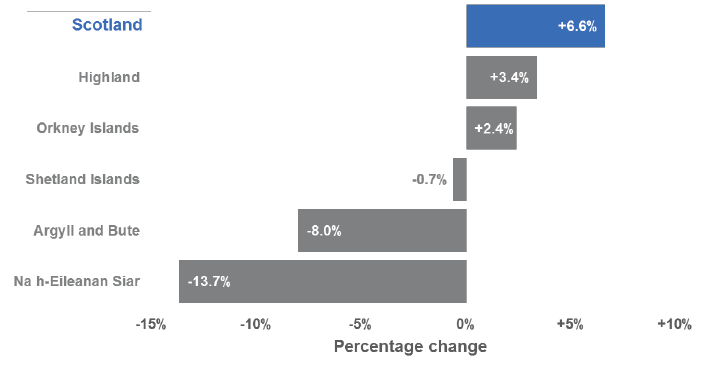Scotland's population needs and migration policy: discussion paper
Discussion paper on evidence, policy and powers for the Scottish Parliament in relation to migration.
Chapter One: Why migration is crucial to Scotland's future prosperity
Population Projections
24. Inward migration brings benefits to Scotland's demography, economy and society.
25. The demographic benefits of migration are made clear in projections from NRS and ONS of Scotland's future population growth. [4] Figure 1.1 demonstrates these projected trends.
26. There are projected to be more deaths than births in every year going forward. Each year for the next 25 years all of Scotland's population growth is projected to come from migration. UK Government policy and the impact of Brexit means that international migration to Scotland is projected to decline, further inhibiting Scotland's population growth.
Figure 1.1: Actual and projected natural change and net international and rest of UK migration in Scotland

Source: Mid-year population estimates and National Population Projections (2016-based), National Records of Scotland, Office for National Statistics
27. The age profile of the population will also change, as Figure 1.2 shows. The proportion of the population of state pension age will increase by 25% in the coming years as the Baby Boomer generation reaches retirement. People aged 75 and over are projected to be the fastest growing age group in Scotland, increasing by 79% over the next 25 years.
28. The prospect of people in Scotland living longer, healthier lives is welcome, and increasingly many people of state pension age continue to work and contribute to the economy in that way. It is also the case that people in the oldest age categories become more likely to need access to health and social care services to support them in old age. Those essential public services will require a buoyant working age population.
Figure 1.2: Estimated and projected age structure of the Scottish population, mid-2016 and mid-2041

Source: National Population Projections (2016-based), National Records of Scotland
29. While we expect to see large increases in the proportion of the population of pensionable age, the working age population will grow only slightly, by around 1%, and the proportion of the population who are children will decline by 1.5%.
Box 1: National Performance Framework
The significance of population growth is recognized in the National Performance Framework, with a Purpose Target on Population to match average European ( EU15) [5] population growth over the period from 2007 to 2017. The population of Scotland has increased each year since 2001 and is now at its highest ever. For the latest year population growth for Scotland has been higher than that of the EU15 countries: in 2016 the average annual population growth rates since 2007 for Scotland and the EU15 were 0.5% and 0.41% respectively. Factors that contributed to this include increased inward migration to Scotland, particularly from the European Union, and low rates of population growth within the EU15.
Fiscal Forecasts
30. Demographic and economic benefits of migration to Scotland are directly linked through growth in the working age population and the impact on tax revenue.
31. The Scottish Fiscal Commission published their first Economic and Fiscal Forecasts in December 2017. [6] The Commission's forecasts directly inform the Scottish Government's budget, particularly through forecasts of income tax receipts. The Commission highlighted that the outlook for income tax is driven by the outlook for earnings and employment. They find that varying levels of migration "have no direct impact on the growth rate of average nominal earnings," but that migration does affect employment level growth.
32. In their analysis, the Commission observed that:
"The size of the population aged 16 to 64, which makes up most of the working age population, is very important for the economy and public finances. These individuals are more likely to be working and will be generating the highest tax receipts, for example, in income tax." – Scottish Fiscal Commission
33. Taking factors including the changing relationship between the UK and EU, demographic change and possible future policy changes into account, the Commission judged that the 50% less future EU migration variant of the population projections was appropriate for Scottish circumstances in preparing their forecasts. Figure 1.3 demonstrates how that variant affects the age structure of the population compared to the principal projections in Scotland and the UK. There is no change expected to the pension age population; the working age population will decline instead of grow and the number of children will decrease even further.
Figure 1.3: Projected population by age group, 50% less future EU migration variant and principal projection, Scotland and UK, 2016-2041

Source: National Population Projections (2016-based), including additional variants using alternative European Union migration assumptions, National Records of Scotland, Office for National Statistics
34. This reflects both the greater significance of migration to Scotland's population growth relative to the rest of the UK, and the greater exposure Scotland faces to reduced inward migration as a consequence of UK policy changes. This outcome would severely impact Scotland's economic prospects.
Box 2: Population Change
There are three aspects of population change: fertility, or the number of births; mortality, or the number of deaths; and migration, or the number of people entering and leaving the country. The difference between the number of people entering and leaving the country is referred to as net migration. If the sum of births and people entering the country is greater than that of deaths and people leaving the country, the population will grow.
(Births – Deaths) + (Immigration – Emigration) = Population Change
Scotland aims to be the best place in the world to grow up, with a range of policy measures to support that including Baby Boxes, the Best Start grant and expanding childcare provision. There is some evidence that support for new parents can have a demographic effect as prospective parents factor that support in when making decisions on family planning. At the other end of the age spectrum, Scotland also aims to ensure that people live longer, healthier lives.
Population growth through new births and prolonged life expectancy is therefore supported and encouraged by devolved policy. However, the age structure of the population is just as important – and perhaps even more so to Scotland – than the overall rate of growth. Scotland, like many developed Western countries, is aging rapidly, and does not have enough people of working age to replace those leaving the labour market as they grow older. Without more working age people, pressures on public services and tax revenue will increase.
Policy interventions that support new births and prolonged life expectancy do not of course immediately increase the working age population. Children do not become working age until 16 years after birth; people over the state pension age are considered to have left the working age population, albeit many remain active in the labour market. The only short-to-medium term measures to grow the working age population are increasing inward migration, or raising the state pension age.
Policy and control over these issues is reserved. Lower levels of migration, in particular from the EU, will result in slower population growth and will have a negative impact on the population sustainability of Scotland and on the working age population in particular.
As the population ages, there is projected to be an increase in the ratio of the number of people of pensionable age to the working age population. In order to maintain this ratio at its current level, the working age population would have to increase by 32,000 per year over the next 25 years.
Economic Growth
35. Migrants who come to Scotland tend to be well educated and highly skilled, help raise productivity and contribute to government revenue. Scottish Government analysis submitted to the Migration Advisory Committee ( MAC) found that the average EU citizen in Scotland adds £10,400 to government revenue and £34,400 to GDP each year. [7] There is some evidence that migration boosts long term GDP per capita, thereby increasing living standards, through diversity of skills and higher innovation activity. [8]
36. New economic modelling in this paper highlights the economic impact of reduced levels of migration. IThe modelling seeks to quantify the impact that lower migration post Brexit could have on the Scottish economy. It estimates that real GDP in Scotland will be 4.5% lower by 2040 than it would have been otherwise, as a result of lower migration. This is equivalent to a fall of almost £5 billion in GDP by 2040.
37. The impact across the rest of the UK of a corresponding reduction in migration is found to be smaller. Real GDP in the rest of the UK will be 3.7% lower by 2040 than it would have been otherwise, as a result of lower migration.
38. Scotland experiences a proportionally larger negative impact relative to the rest of the UK. The proportionately larger impact on Scotland is equivalent to £1.2 billion a year by 2040.
39. The modelling also suggests that if the UK Government was to meet its target to reduce net migration to the 'tens of thousands', real GDP would fall in Scotland by 9.3% compared to a fall in the rest of the UK of 7.6%. [9]
40. As well as contributing to employment level growth and GDP, there is evidence – set out in the technical annex - that migrants can also have a dynamic effect in helping to improve productivity. Migrant workers bring new skills and expertise and typically have high levels of entrepreneurship which helps lay the foundations for future economic growth.
41. The large number of EU and international students that come to study in Scotland also add to the diversity of our communities, enrich the learning experience and, in the case of those who can remain in Scotland, go on to contribute to economic prosperity.
42. The available evidence does not suggest that migration has a statistically significant impact on wages and employment opportunities for the non-migrant population. We have high levels of employment in Scotland and invest around £100 million per year in apprenticeships, flexible workforce development and individual training accounts.
43. The Programme for Government also committed to publishing an evidence‑based discussion paper on employment setting out how the Scottish Parliament could more effectively tackle issues of low pay and poor working practices and protect workers' rights against any post-Brexit race to the bottom. A further discussion paper on social security and employment support will set out how a more comprehensive devolution of social security and employment support would allow the Scottish Parliament to deliver a more joined up system for those in and out of work; tackle poverty more effectively; and consider more fundamental options for long-term reform. We are committed to reducing barriers to employment but in addition to supporting the skills of those people currently resident in Scotland we also need to grow our workforce.
People and Places
44. Migration not only enhances our economic prospects and contributes to our demographic sustainability, it also enriches our culture and strengthens our society. Migrants contribute to a diverse, open and modern society and there is also some evidence to suggest that they increase qualities of tolerance, inclusiveness and openness to intercultural learning amongst Scottish citizens. [10]
45. Migration supports key places such as our rural communities, bringing a supply of labour to the rural economy and helping sustain essential public services including healthcare and schools. The importance of migration to rural communities and services was highlighted in both Scotland's Place in Europe: People, Jobs and Investment, and the Scottish Government submission to the MAC.
46. Ageing and declining rural populations heighten the need for migrants. For example, in the Highlands and Islands, the combination of lower levels of unemployment with growth in important sectors such as tourism and food and drink has attracted migrants to live and work in rural areas. Between 2005 and 2015, around 20% of total estimated population growth in the Highland Council area came from people born outside the UK.
47. Despite this in-migration of economically active people, the long-term trend in the Highlands and Islands remains one of an ageing demographic and out-migration of young people in search of educational and employment opportunities. In addition to this, many areas of the Highlands and Islands are projected to decline in population in the near future. Figure 1.4 shows that Na h-Eileanan Siar is projected to experience a decline in population of 13.7% between 2014 and 2039, which is the largest decrease for any council area in Scotland. All of the council areas in the Highlands and Islands region are projected to experience lower levels of population increase than Scotland as a whole. This emphasises the importance of migration for the sustainability of Scotland's rural communities.
Figure 1.4: Projected percentage change in total population, Scotland and Highlands and Islands council areas, 2014-2039

Source: Sub-national Population Projections, 2014-based, National Records of Scotland
48. Although an ageing population as a welcome result of people living longer is a challenge the rest of the UK is also facing, the impact of any reduction in migration in the overall age profile of the country is of much greater significance to Scotland. Migrants tend to be younger than the rest of the population and more likely to be of working and child bearing age. They can therefore play an important role in boosting the overall population. This demonstrates the importance of migrant families who settle in Scotland, not just temporary workers. Evidence also suggests that school performance and pupil achievement may be enhanced by the presence of migrants in schools. [11]
Principles for policy on migration
49. This chapter has made clear the demographic, economic and social benefits of migration to Scotland. It also highlights the negative impacts if migration was to fall. Given these factors, the Scottish Government believes that the rules and systems governing migration to Scotland should be managed in a way that supports these demographic, economic and social considerations.
50. There are many questions to consider and perspectives to reflect on when thinking about future migration policy. This paper suggests seven principles, described below, that attempt to capture these. For example, they aim to balance accessibility for migrants and employers with necessary control measures to ensure security and integrity of the system.
51. Considering the characteristics of policy and systems on future migration, the following principles should apply:
i. Migration policy should address the needs of all of Scotland, including those areas most at risk of depopulation.
ii. Migration policy should encourage long-term settlement in Scotland of people with the skills we need who will work, raise families and make a positive contribution to society.
iii. Scotland should be able to attract the best talent from Europe and across the world to work and study here without excessive barriers and our migration policy should support mobility, collaboration and innovation.
iv. Migration policy should support fair work, protecting workers rights, pay and access to employment and preventing exploitation and abuse.
v. People who are entitled to live in Scotland – both international migrants and UK citizens – should be able to bring close family with them and migrants should have access to services and support to encourage integration into communities.
vi. The migration system should be easy to access and understand and focused on what a prospective migrant can contribute, not on their ability to pay - therefore fees and charges should be proportionate.
vii. Migration should be controlled to deter and prevent abuse, fraud and criminal activity, including terrorism, human trafficking and other serious offences.
Box 3: Human Rights
Migration takes place within an international human rights framework that provides important legal protections. These safeguards are particularly strong within the current EU context. Existing EU law guarantees a wide range of fundamental rights and provides protection against discrimination and exploitation. Being in the EU also helps to underpin rights derived from sources such as the European Convention on Human Rights. Important obligations also exist in United Nations and Council of Europe treaties and International Labour Organisation conventions.
Brexit threatens to undermine many of the most important existing EU safeguards – affecting both EU citizens and third country nationals. For example, people from outside the EU who are married to EU citizens could in the future find it more difficult to come to the UK than they do at present. Brexit risks weakening other rights currently enjoyed by migrant workers, who will lose access to EU legal remedies and face greater uncertainty.
Scotland's desire to uphold the highest standards, and to meet our international obligations in full, means the case for new powers is both persuasive and pressing. Human rights are may already devolved given effect to Scotlandby the Scottish Parliament, but additional powers in areas such as migration would be needed if the Scottish Government is to take the full range of actions that are necessary. These new powers would be exercised in a way that ensures Scotland demonstrates leadership on human rights and continues to protect the interests of every member of Scottish society.
Contact
There is a problem
Thanks for your feedback